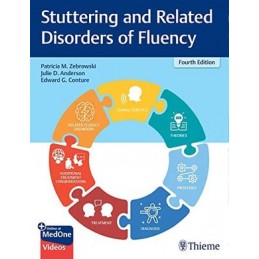- Reduced price

Order to parcel locker

easy pay


 Delivery policy
Delivery policy
Choose Paczkomat Inpost, Orlen Paczka, DHL, DPD or Poczta Polska. Click for more details
 Security policy
Security policy
Pay with a quick bank transfer, payment card or cash on delivery. Click for more details
 Return policy
Return policy
If you are a consumer, you can return the goods within 14 days. Click for more details
A student-friendly resource on stuttering and related fluency disorders by a whos who of global experts
Stuttering and Related Disorders of Fluency, Fourth Edition honors the philosophy that discoveries of the past are the bedrock of the present and the inspiration for future explorations—in this context—the nature and treatment of stuttering. Initially developed over 30 years ago, the first two editions were edited by the late Richard F. Curlee and the third edition was co-edited by Richard F. Curlee and Edward G. Conture. The latest edition, co-edited by Patricia M. Zebrowski, Julie D. Anderson, and Edward G. Conture, brings together contemporary insights and a multinational perspective from 44 world-class academicians, clinicians, and researchers in the field of stuttering and related disorders.
The book is organized into six sections and 17 chapters, with the first section describing basic facts and theories. The second section covers genetic, neural, linguistic, cognitive, and physiological factors. The third section features three dedicated chapters on the diagnosis of preschool-age children, school-age children, and adolescents and adults. The fourth section discusses treatment guidelines with three chapters organized by the same age demographics, while the fifth section covers language and phonological, bilingual and multicultural, and pharmacological considerations for treatment. The sixth, and last, section provides guidance on cluttering and acquired stuttering—from causes and symptoms to diagnosis and treatment.
Key Highlights
This text is essential reading for upper-class undergraduates and early-stage graduate students in communication sciences and disorders. It also provides an invaluable classroom tool for instructors teaching basic courses on this subject and is a helpful sourcebook for researchers investigating stuttering and related fluency disorders.
This print book includes complimentary access to a digital copy on https://medone.thieme.com.
Data sheet
Section I: Some Characteristics and Theories
1 Common Characteristics
2 Some 20th- and 21st-Century Theories of Stuttering: A Brief Overview
Section II: Processes Associated with Stuttering
3 Genetic Processes
4 Speech, Language, and Cognitive Processes
5 Neural and Physiological Processes
6 Temperamental and Emotional Processes
Section III: Diagnosis of Stuttering
7 Preschool-Age Children
8 School-Age Children
9 Adolescents and Adults
Section IV: Treatment of Stuttering
10 Preschool-Age Children
11 School-Age Children
12 Adolescents and Adults
Section V: Additional Treatment Considerations
13 Language and Phonological Considerations
14 Bilingual and Multicultural Considerations
15 Pharmacological Considerations
Section VI: Related Fluency Disorders
16 Cluttering: Etiology, Symptomatology, Identification, and Treatment
17 Acquired Stuttering: Etiology, Symptomatology, Identification, and Treatment
